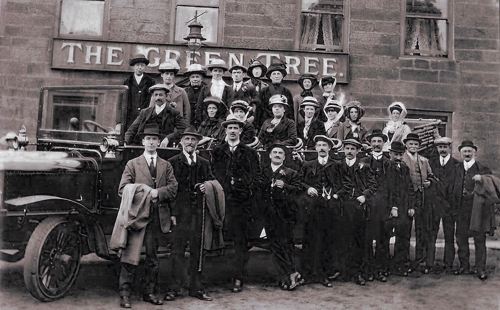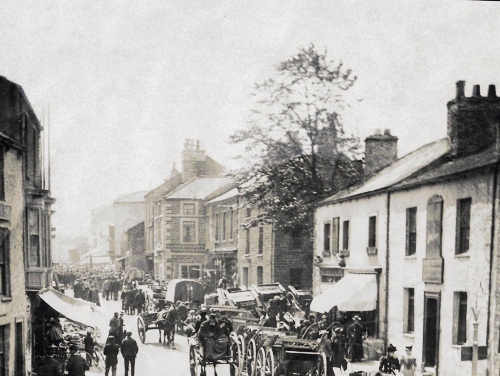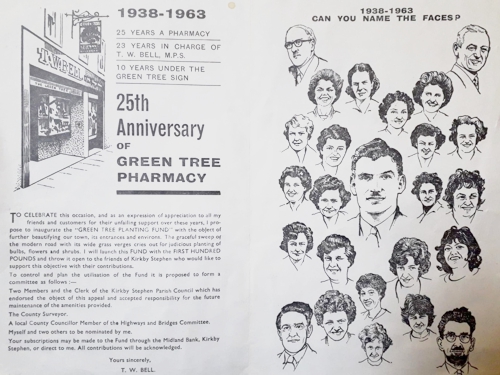.jpg)
Formerly known as THE WHITE SWAN
.jpg)
The Green
Tree Inn behind the tree trunk in the mid distance (from an old postcard).
Robert
Walker (b.1790) was a part-time farmer and ran the White Swan with his wife Jane
(b.1802) from at least 1829[3]
until after 1861 when his wife took over the reins officially.
Both Robert (aged 83) and Jane (aged 72) died in 1873.[4]
The
White Swan then appears to be empty or unlicensed for a while as the next record
is for The Green Tree in 1884 with W Ellison[5]
as the landlord. This green tree
name arises from a tree that was beside the building dating from before
Fawcett’s 1817 drawing, an obvious landmark in the otherwise tree-less Market
Street. Whilst the tree has long gone, the current Pharmacy still retains the
name. Unfortunately, no one appears to have recorded what species of tree it was
(though one unconfirmable source says "elm")
or even when it was planted.

The Green Tree inn, pre-WW1
The
licensed premises included the rear house which is still evident today from the
interior as a pub. The business included the southern section of the front then
pair of small shops. The rear Green Tree Yard was another area in the town where
there was poorer housing to rent and was particularly used for early railway
workers. The Green Tree Inn disappears from the records by 1911.
The
information below has been taken from UK Census Records and historical trade
directories.
White
Swan Robert Walker
1829/41/51/58/61
Jane Walker
1869/71/73
Green
Tree W.
Ellison
1884
James H. Fawcett
1891
Elizabeth Hayton
1897
Henry Anderson
1905
After
returning home from his WWII service, William Henry (Harry) Littlefair opened
his ironmongers and builders’ merchant new business in 1947 at the former
Green Tree Inn. ‘Mr Littlefair has taken the last available premises in the
commercial heart of the town ….’[6]
Next door at this time in the northern side of the building, was Bell’s
Chemist.
(In
1954, W. H. Littlefair moved to larger premises at 18/20 Market Street, formerly
the New Fountain Inn, where the Builders’ Merchant business would grow. Later,
under son, Arthur W. Littlefair, the business expanded even further, into
adjoining premises until their move to newly built premises in Hobson’s Lane
and it was eventually sold to J.T. Atkinson.)

The tree shown on a pre-WWI market day
Meanwhile,
back at the former Green Tree Inn, Johnstones, the confectioners and café
owners on Fletcher Hill, (since demolished) would be the subsequent occupier of
the shop and are remembered as selling ice creams at these premises.
T.W.
(Bill) Bell later extended the Chemist's shop into both sides of the building,
naming the combined property “The Green Tree Pharmacy” in 1953.
In 1963, T.W. Bell celebrated the pharmacy’s 25 years (1938-1963) with
the launch of their “Green Tree Planting Fund”, see below for the proposal
leaflet which included drawings of the owners and staff at the time.

Bell’s Chemist fund sheet
[1]
SWAILES Anne and Alec, Kirkby Stephen, Titus Wilson & Son Ltd., 1985
p.95/6
[2]
Ditto p.97
[3]
McKAY Barry and WILSON Chris (Compiled and edited by), Kirkby Stephen at
Work 1780-1905, Appleby Record Society
[4]
Westmorland Death Registers Oct/Nov/Dec 1873 10b 481 and 10b 473
[5]
McKAY Barry and WILSON Chris (Compiled and edited by), Kirkby Stephen at
Work 1780-1905, Appleby Record Society
[6]
With thanks to Arthur Littlefair MBE for this document quote and
information.